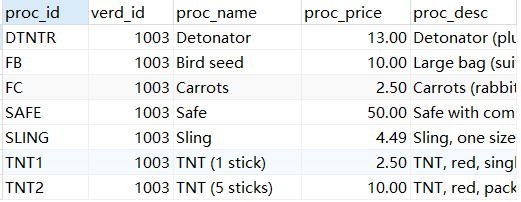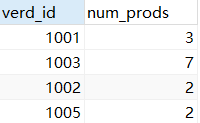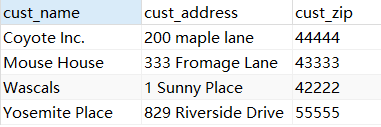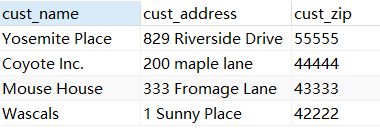在上篇博客MySql必知必会实战练习(一)表创建和数据添加中完成了各表的创建和数据添加,下面进行数据检索和过滤操作。
1. Select子句使用顺序
select--->DISTINCT--->from--->where--->GROUP BY--->HAVING--->ORDER BY--->LIMIT
(1)DISTINCT
select verd_id from products;

使用DISTINCT检索出不同值的列表
select DISTINCT verd_id from products;

(2)Group By
首先看下下面3个查询语句的结果:
select count(*) from products;
select * from products where verd_id = 1003;
select count(*) from products where verd_id = 1003;
(1) (2)
(2) (3)
(3) 
(1)表示products表的总项数14
(2)列出了verd_id为1003的所有项
(3)显示verd_id为1003的总项数7
再看下面语句的输出结果:
select verd_id, count(*) as num_prods from products GROUP BY verd_id;

结果一目了然,分别对verd_id进行分组,并显示各组的总项数。
注:如果再select中使用表达式,则必须再GROUP BY字句中指定相同的表达式,不能使用别名。
(3)HAVING
HAVING语句主要是对分组语句进行过滤,WHERE过滤指定的是行而不是分组,事实上,WHERE没有分组的概念
HAVING与WHERE的唯一差别就是WHERE过滤行,HAVING过滤分组
select verd_id, count(*) as num_prods from products GROUP BY verd_id HAVING count(*)>2;

select verd_id, count(*) as num_prods from products GROUP BY verd_id HAVING verd_id = 1003;

(4)ORDER BY
select cust_name,cust_address,cust_zip from customers;

对cust_zip排序
select cust_name,cust_address,cust_zip from customers ORDER BY cust_zip;

对多列进行排序
select cust_name,cust_address,cust_zip from customers ORDER BY cust_address,cust_zip;

指定排序方向:默认升序(ASC),为了进行降序排序,必须指定DESC关键字
select cust_name,cust_address,cust_zip from customers ORDER BY cust_zip DESC;

(5)LIMIT
LIMIT关键子对输出的行数限制,指定其实行和行数
select cust_name,cust_address,cust_zip from customers ORDER BY cust_zip DESC LIMIT 2,4;

(6)综合使用
select verd_id, count(*) as num_prods from products GROUP BY verd_id HAVING count(*) > 0 ORDER BY verd_id DESC LIMIT 1,3;
